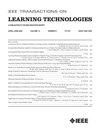Predicting Student Performance in a Programming Tutoring System Using AI and Filtering Techniques
IF 4.9
3区 教育学
Q2 COMPUTER SCIENCE, INTERDISCIPLINARY APPLICATIONS
引用次数: 0
Abstract
In recent years, there has been an increasing trend of utilizing artificial intelligence (AI) methodologies over traditional statistical methods for predicting student performance in e-learning contexts. Notably, many researchers have adopted AI techniques without conducting a comprehensive investigation into the most appropriate and accurate approach to employ. Additionally, determining the optimal input parameters for each AI technique remains a pertinent question in this domain. This study employs machine learning (ML) and artificial neural networks (ANN) to predict student grades within a programming tutoring system. The experiment involved university students whose interaction data with the e-learning system were analyzed and used for predictions. By identifying the structural relationships between the properties of the input data, this research aims to determine the most efficient AI method for accurately predicting student performance in e-learning systems. The structure of the input data in these systems is described by variables related to individual student activities, so correlations between variables were a natural starting point for further theoretical considerations. In this manner, by applying a filtering technique based on the minimum redundancy–maximum relevance (mrMR) criterion, it was shown that correlations among predictors and between predictors and the target variable play a significant role in defining the appropriate model for predicting student grades. The results showed that ANN (the Levenberg–Marquardt algorithm with Bayesian regularization) outperformed ML methods, achieving the highest prediction accuracy. The results obtained from this study can be of great importance for learning technologies engineering and AI in general.利用人工智能和过滤技术预测编程辅导系统中的学生成绩
近年来,利用人工智能(AI)方法而非传统统计方法预测电子学习环境中学生成绩的趋势日益明显。值得注意的是,许多研究人员在采用人工智能技术时,并没有对最合适、最准确的方法进行全面调查。此外,确定每种人工智能技术的最佳输入参数仍然是该领域的一个相关问题。本研究采用机器学习(ML)和人工神经网络(ANN)来预测编程辅导系统中的学生成绩。实验涉及大学生,对他们与电子学习系统的交互数据进行了分析并用于预测。通过确定输入数据属性之间的结构关系,本研究旨在确定最有效的人工智能方法,以准确预测电子学习系统中的学生成绩。这些系统中输入数据的结构是由与学生个人活动相关的变量来描述的,因此变量之间的相关性自然成为进一步理论考虑的出发点。通过这种方式,应用基于最小冗余-最大相关性(mrMR)准则的过滤技术,证明了预测变量之间以及预测变量与目标变量之间的相关性在确定预测学生成绩的适当模型方面起着重要作用。结果表明,ANN(采用贝叶斯正则化的 Levenberg-Marquardt 算法)优于 ML 方法,预测准确率最高。本研究获得的结果对学习技术工程和人工智能具有重要意义。
本文章由计算机程序翻译,如有差异,请以英文原文为准。
求助全文
约1分钟内获得全文
求助全文
来源期刊

IEEE Transactions on Learning Technologies
COMPUTER SCIENCE, INTERDISCIPLINARY APPLICATIONS-
CiteScore
7.50
自引率
5.40%
发文量
82
审稿时长
>12 weeks
期刊介绍:
The IEEE Transactions on Learning Technologies covers all advances in learning technologies and their applications, including but not limited to the following topics: innovative online learning systems; intelligent tutors; educational games; simulation systems for education and training; collaborative learning tools; learning with mobile devices; wearable devices and interfaces for learning; personalized and adaptive learning systems; tools for formative and summative assessment; tools for learning analytics and educational data mining; ontologies for learning systems; standards and web services that support learning; authoring tools for learning materials; computer support for peer tutoring; learning via computer-mediated inquiry, field, and lab work; social learning techniques; social networks and infrastructures for learning and knowledge sharing; and creation and management of learning objects.
 求助内容:
求助内容: 应助结果提醒方式:
应助结果提醒方式:


